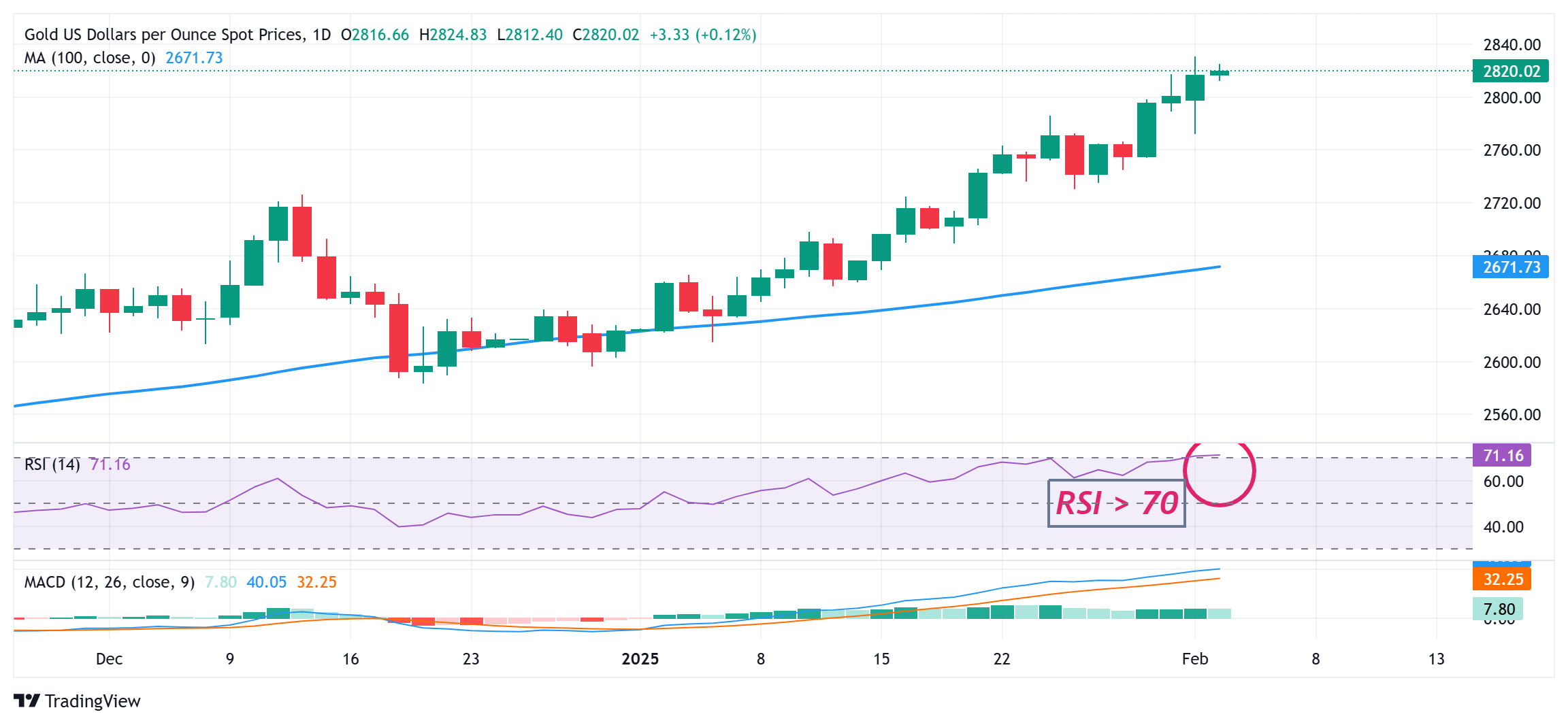- Gold price consolidates its recent strong gains to a record high touched on Monday.
- Rebounding US bond yields and a modest USD uptick cap gains for the commodity.
- Worries about Trump’s tariffs and inflation concerns lend support to the XAU/USD.
Gold price (XAU/USD) extends its steady intraday retracement slide from the vicinity of the all-time peak and drops to a fresh daily low during the first half of the European session. Trump’s decision to temporarily pause tariffs on Mexico and Canada, after striking a border security deal with both nations, boosts investors’ confidence. The risk-on flow, along with the Federal Reserve’s (Fed) hawkish pause last week, provides a modest lift to the US Treasury bond yields. This, in turn, assists the US Dollar (USD) to regain positive traction following the previous day’s turnaround and undermines the commodity.
Any meaningful corrective slide for the Gold price, however, remains cushioned in the wake of concerns about the potential economic fallout from US President Donald Trump’s trade tariffs. Furthermore, expectations that Trump’s protectionist policies would result in higher US inflation could benefit the precious metal’s status as a hedge against rising prices and help limit the downside. This, in turn, suggests that the path of least resistance for the bullion remains to the upside and supports prospects for the emergence of dip-buying at lower levels, warranting some caution for aggressive bearish traders.
Gold price is weighed down by modest USD strength and positive risk tone
- US President Donald Trump’s tariff plans continue to fuel concerns about a global trade war and its impact on the economy, lifting the safe haven Gold price to a fresh all-time peak on Monday.
- The Institute for Supply Management’s (ISM) Manufacturing Purchasing Managers’ Index climbed from 49.3 in the previous month to 50.9 in January, beating expectations for a reading of 49.8.
- Additionally, the Prices Paid Index—which measures inflation—rose to 54.9 from 52.5, while the Employment Index increased to 50.3 from 45.4, and the New Orders Index improved to 55.1.
- This comes on top of speculations that Trump’s trade tariffs could push up inflation and give the Federal Reserve less impetus to cut interest rates further, which underpins the US Dollar.
- The view was echoed by comments from Chicago Fed President Austan Goolsbee, who warned that uncertainty over Trump’s policies could delay the central bank’s plans to cut interest rates.
- Separately, Atlanta Fed President Raphael Bostic noted on Monday that although the US labor market remains surprisingly resilient, tariff threats throw a wrench in outlook expectations.
- Trump’s policies could push up inflation, which, along with expectations for further policy easing by the Federal Reserve, turn out to be another factor benefiting the non-yielding yellow metal.
- Trump temporarily paused tariffs on Mexico and Canada after striking a border security deal, which boosts investors’ confidence and might cap any further move-up for the safe-haven XAU/USD.
- The US Dollar attracts some dip-buyers following the previous day’s turnaround from the vicinity of over a two-year high and might hold back bulls from placing fresh bets around the commodity.
- Tuesday’s US economic docket features the release of Job Openings and Labor Turnover Survey (JOLTS) and Factory Orders data, which might provide some impetus to the USD and the Gold price.
Gold price technical setup favors bullish traders; $2,773-2,772 holds the key
From a technical perspective, the Relative Strength Index (RSI) is already flashing slightly overbought conditions on the daily chart. This makes it prudent to wait for some near-term consolidation or a modest pullback before the next leg up. That said, any corrective slide below the $2,800 immediate support might still be seen as a buying opportunity and remain limited near the $2,773-2,772 horizontal resistance breakpoint. Some follow-through selling, however, could pave the way for a further decline towards the $2,755 zone en route to the $2,725-2,720 region and the $2,700 mark.
On the flip side, bulls are likely to pause near the $2,830 area, or the record peak touched on Monday. Some follow-through buying, however, will set the stage for an extension of a well-established trend witnessed from the December swing low, around the $2,583 region.
Risk sentiment FAQs
In the world of financial jargon the two widely used terms “risk-on” and “risk off” refer to the level of risk that investors are willing to stomach during the period referenced. In a “risk-on” market, investors are optimistic about the future and more willing to buy risky assets. In a “risk-off” market investors start to ‘play it safe’ because they are worried about the future, and therefore buy less risky assets that are more certain of bringing a return, even if it is relatively modest.
Typically, during periods of “risk-on”, stock markets will rise, most commodities – except Gold – will also gain in value, since they benefit from a positive growth outlook. The currencies of nations that are heavy commodity exporters strengthen because of increased demand, and Cryptocurrencies rise. In a “risk-off” market, Bonds go up – especially major government Bonds – Gold shines, and safe-haven currencies such as the Japanese Yen, Swiss Franc and US Dollar all benefit.
The Australian Dollar (AUD), the Canadian Dollar (CAD), the New Zealand Dollar (NZD) and minor FX like the Ruble (RUB) and the South African Rand (ZAR), all tend to rise in markets that are “risk-on”. This is because the economies of these currencies are heavily reliant on commodity exports for growth, and commodities tend to rise in price during risk-on periods. This is because investors foresee greater demand for raw materials in the future due to heightened economic activity.
The major currencies that tend to rise during periods of “risk-off” are the US Dollar (USD), the Japanese Yen (JPY) and the Swiss Franc (CHF). The US Dollar, because it is the world’s reserve currency, and because in times of crisis investors buy US government debt, which is seen as safe because the largest economy in the world is unlikely to default. The Yen, from increased demand for Japanese government bonds, because a high proportion are held by domestic investors who are unlikely to dump them – even in a crisis. The Swiss Franc, because strict Swiss banking laws offer investors enhanced capital protection.
Tariffs FAQs
Tariffs are customs duties levied on certain merchandise imports or a category of products. Tariffs are designed to help local producers and manufacturers be more competitive in the market by providing a price advantage over similar goods that can be imported. Tariffs are widely used as tools of protectionism, along with trade barriers and import quotas.
Although tariffs and taxes both generate government revenue to fund public goods and services, they have several distinctions. Tariffs are prepaid at the port of entry, while taxes are paid at the time of purchase. Taxes are imposed on individual taxpayers and businesses, while tariffs are paid by importers.
There are two schools of thought among economists regarding the usage of tariffs. While some argue that tariffs are necessary to protect domestic industries and address trade imbalances, others see them as a harmful tool that could potentially drive prices higher over the long term and lead to a damaging trade war by encouraging tit-for-tat tariffs.
During the run-up to the presidential election in November 2024, Donald Trump made it clear that he intends to use tariffs to support the US economy and American producers. In 2024, Mexico, China and Canada accounted for 42% of total US imports. In this period, Mexico stood out as the top exporter with $466.6 billion, according to the US Census Bureau. Hence, Trump wants to focus on these three nations when imposing tariffs. He also plans to use the revenue generated through tariffs to lower personal income taxes.






